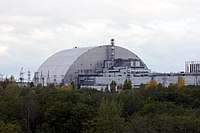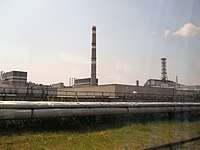
The developers of the reactor plant considered this combination of events to be impossible and therefore did not allow for the creation of emergency protection systems capable of preventing the combination of events that led to the crisis, namely the intentional disabling of emergency protection equipment plus the violation of operating procedures. Thus the primary cause of the accident was the extremely improbable combination of rule infringement plus the operational routine allowed by the power station staff. ~ Atomic Energy

We were just not prepared for that sort of situation. ~ Mikhail Gorbachev

In 1986, in what was the Soviet Republic of Ukraine, the Chernobyl nuclear reactor exploded, releasing 400 times more radioactive material than the Hiroshima Bomb. Thirty workers died; 50,000 people fled the nearest city, and the radioactive fallout spread over Europe. ~ PBS
Mankind has never experienced a misfortune of this magnitude, with consequences so grave and so hard to eliminate. ~ Boris Yeltsin
The Chernobyl disaster (Ukrainian: Чорнобильська катастрофа, Chornobylska Katastrofa – Chornobyl Catastrophe) was a nuclear accident that occurred on 26 April 1986 at the Chernobyl Nuclear Power Plant in Ukraine (then officially Ukrainian SSR). An explosion and fire released large quantities of radioactive contamination into the atmosphere, which spread over much of Western USSR and Europe. It is one of only two classified as a level 7 event on the International Nuclear Event Scale (the other being the Fukushima Daiichi nuclear disaster in 2011).
Quotations of statements made during the events of the Chernobyl disaster
- For the attention of the residents of Pripyat! The City Council informs you that due to the accident at Chernobyl Power Station in the city of Pripyat the radioactive conditions in the vicinity are deteriorating. The Communist Party, its officials and the armed forces are taking necessary steps to combat this. Nevertheless, with the view to keep people as safe and healthy as possible, the children being top priority, we need to temporarily evacuate the citizens in the nearest towns of Kiev region. For these reasons, starting from April 27, 1986 2 pm each apartment block will be able to have a bus at its disposal, supervised by the police and the city officials. It is highly advisable to take your documents, some vital personal belongings and a certain amount of food, just in case, with you. The senior executives of public and industrial facilities of the city has decided on the list of employees needed to stay in Pripyat to maintain these facilities in a good working order. All the houses will be guarded by the police during the evacuation period. Comrades, leaving your residences temporarily please make sure you have turned off the lights, electrical equipment and water and shut the windows. Please keep calm and orderly in the process of this short-term evacuation.
- Evacuation announcement in Pripyat, 27 April 1986 (14:00)
- There has been an accident at the Chernobyl Nuclear Power Plant. One of the nuclear reactors was damaged. The effects of the accident are being remedied. Assistance has been provided for any affected people. An investigative commission has been set up.
- Vremya, 28 April 1986 (21:00)
Quotes
- The risk projections suggest that by now [2006] Chernobyl may have caused about 1000 cases of thyroid cancer and 4000 cases of other cancers in Europe, representing about 0.01% of all incident cancers since the accident. Models predict that by 2065 about 16,000 cases of thyroid cancer and 25,000 cases of other cancers may be expected due to radiation from the accident, whereas several hundred million cancer cases are expected from other causes.
- Cardis, Elisabeth; Krewski, Daniel; Boniol, Mathieu; Drozdovitch, Vladimir; Darby, Sarah C.; Gilbert, Ethel S.; Akiba, Suminori; Benichou, Jacques; Ferlay, Jacques; Gandini, Sara; Hill, Catherine; Howe, Geoffrey; Kesminiene, Ausrele; Moser, Mirjana; Sanchez, Marie; Storm, Hans; Voisin, Laurent; Boyle, Peter (2006). "Estimates of the cancer burden in Europe from radioactive fallout from the Chernobyl accident". International Journal of Cancer. 119 (6): 1224. doi:10.1002/ijc.22037. PMID 16628547.
- The developers of the reactor plant considered this combination of events to be impossible and therefore did not allow for the creation of emergency protection systems capable of preventing the combination of events that led to the crisis, namely the intentional disabling of emergency protection equipment plus the violation of operating procedures. Thus the primary cause of the accident was the extremely improbable combination of rule infringement plus the operational routine allowed by the power station staff.
- "Expert report to the IAEA on the Chernobyl accident" (in Russian). 61. Atomic Energy. 1986.
- NARRATOR: In 1986, in what was the Soviet Republic of Ukraine, the Chernobyl nuclear reactor exploded, releasing 400 times more radioactive material than the Hiroshima Bomb. Thirty workers died; 50,000 people fled the nearest city, and the radioactive fallout spread over Europe. It was the world's worst nuclear accident.
Thirty years later, its hastily built enclosure is crumbling. In a race against time, engineers are struggling to prevent another catastrophic release of deadly radioactive debris into the environment. - NARRATOR: In the vicinity of the reactor, the radioactive fallout forced a third-of-a-million people to evacuate, never to return.
It remains the world's worst-ever nuclear power plant disaster. It left the Soviet authorities with a monumental problem: around 200 tons of shattered uranium fuel rods and other radioactive debris remained inside the damaged reactor building. Left uncovered, it would continually release radioactive dust into the air, a poisonous cloud to threaten the surrounding area.
Over the next six months, workers braved extreme radiation to seal the reactor inside a 300,000-ton shelter, made from steel and concrete. It came to be called the "sarcophagus."
But it was flawed from the start. The extreme radiation prevented the workers from completing the welds needed to seal the prefabricated sections of the sarcophagus together.
- PBS, "Building Chernobyl's MegaTomb", NOVA, (April 26, 2017).
- The accident at the Chernobyl nuclear power station was graphic evidence, not only of how obsolete our technology was, but also of the failure of the old system. At the same time, and such is the irony of history, it severely affected our reforms by literally knocking the country off its tracks.
- Mikhail Gorbachev, Memoirs (1995).
- I absolutely reject the accusation that the Soviet leadership intentionally held back the truth about Chernobyl. We simply did not know the whole truth yet.
- Mikhail Gorbachev, Memoirs (1995).
- We were just not prepared for that sort of situation.
- Mikhail Gorbachev, admitted in April 1996, ten years after the great mishap.
- Quoted in Firm Hope Amid Chernobyl’s Gloom in Awake! magazine, April 22, 1997, published by Jehovah's Witnesses.
- The analysis of mutation rates in genomic repeat elements has also been applied to study transgenerational IR effects in human populations, namely in individuals living in the vicinity of the Chernobyl reactor accident or near nuclear test sites (Semipalatinsk, [Kazakhstan]]; Dubrova et al., 1996, 2002a, b). In all of these studies, they found an increase in the mutation rate among the progeny of the exposed parents. Taken together, these data support the hypothesis that exposure to IR can induce germline genomic instability that may predispose future generations to an increase risk of genetic diseases, infertility, and even cancer.
- Matt Merrifield and Olga Kovalchuk, “Epigenetics in radiation biology: a new research frontier”, Front. Genet.”, (04 April 2013).
- The Chernobyl accident in April 1986 caused the deposition of radionuclides across Europe, followed by a long-term artificial increase of the radiation background [1]. In addition to the classical subject of mutagenesis after acute radiation exposure [2], the study of the time course of biological damage associated with chronic low-dose radiation exposure of mammals and the endeavors to predict biological damage in consecutive generations have become a relevant issue. Since there is little information on this topic [3, 4], the present work addresses these important questions. Starting with 1986, we were engaged in studying bio-logical effects of chronic low dose radiation in natural populations of bank vole (Clethrionomys glareolus, Schre-ber) in a series of many animal generations. The bank vole is a widespread rodent species that is used as indicator of environmental quality. It is a convenient object for many genetic tests, which originally have been devised for the laboratory mouse [5]. Comparison of own and literature data on doubling doses of acute irradiation for chromosome injuries had shown that the sensitivity of somatic cells of the bank vole to ionizing radiation is very similar to the sensitivity of human lymphocytes and germ cells of laboratory mice.
- Nadezhda I. Ryabokon; R. I. Goncharova, “Transgenerational accumulation of radiation damagein small mammals chronically exposed to Chernobyl fallout”,Radiat Environ Biophys (2006) 45: 167–177 (Received: 5 March 2006 / Accepted: 17 June 2006 / Published online: 22 July 2006© Springer-Verlag 2006)
- Mankind has never experienced a misfortune of this magnitude, with consequences so grave and so hard to eliminate.
- Boris Yeltsin
- Quoted in Firm Hope Amid Chernobyl’s Gloom in Awake! magazine, April 22, 1997, published by Jehovah's Witnesses.
External links
This article is issued from
Wikiquote.
The text is licensed under Creative
Commons - Attribution - Sharealike.
Additional terms may apply for the media files.